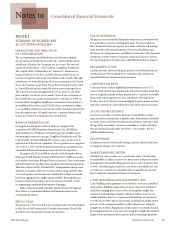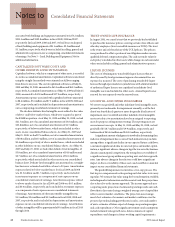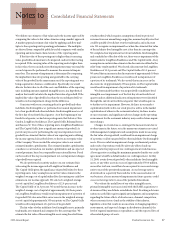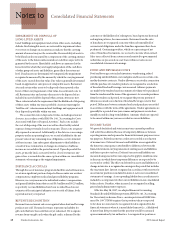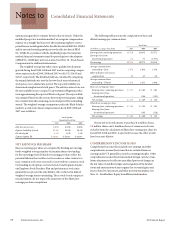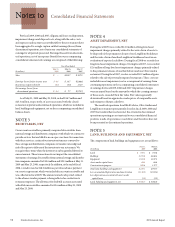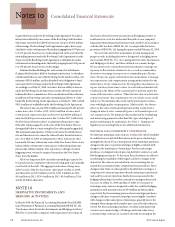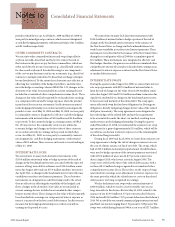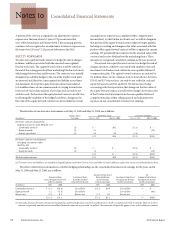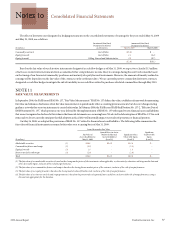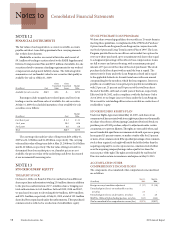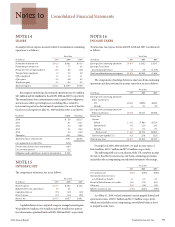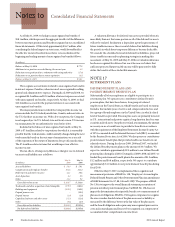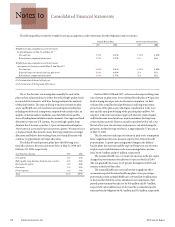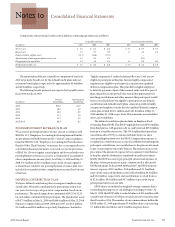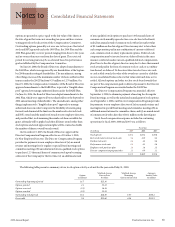Red Lobster 2009 Annual Report Download - page 57
Download and view the complete annual report
Please find page 57 of the 2009 Red Lobster annual report below. You can navigate through the pages in the report by either clicking on the pages listed below, or by using the keyword search tool below to find specific information within the annual report.
2009 Annual Report Darden Restaurants, Inc. 55
Notes to Consolidated Financial Statements
period in which they occur. As of May 31, 2009 and May 25, 2008 we
were party to natural gas swap contracts, which were not designated
as cash flow hedging instruments, with notional values of $1.3 million
and $3.1 million respectively.
OTHER COMMODITY CONTRACTS
We enter into other commodity futures and swaps (typically for
soybean oil, milk, diesel fuel and butter) to reduce the risk of
fluctuations in the price we pay for these commodities, which are
either used directly in our restaurants (e.g., class III milk contracts
for cheese and soybean oil for salad dressing) or are components
of the cost we pay for items used in our restaurants (e.g., diesel fuel
contracts to mitigate risk related to diesel fuel surcharges charged
by our distributors). To the extent these derivatives are effective in
offsetting the variability of the hedged cash flows, and otherwise
meet the hedge accounting criteria of SFAS No. 133, changes in the
derivatives’ fair value are not included in current earnings but are
included in accumulated other comprehensive income (loss). These
changes in fair value will subsequently be reclassified into earnings
as a component of food and beverage expenses when the product
is purchased for use in our restaurants. Ineffectiveness measured
in the hedging relationship is recorded currently in earnings in the
period it occurs. As of May 31, 2009 and May 25, 2008, we were party
to commodity contracts designated as effective cash flow hedging
instruments with notional values of $0.0 million and $5.8 million,
respectively. To the extent the hedge accounting criteria of SFAS
No. 133 are not met, the commodity contracts are utilized as
economic hedges and changes in the fair value of these contracts
are recorded currently in earnings in the period in which they
occur. As of May 31, 2009, we were party to commodity contracts
not designated as cash flow hedging instruments, with notional
values of $0.3 million. There were no such contracts outstanding as
of May 25, 2008.
INTEREST RATE LOCKS
We entered into treasury-lock derivative instruments with
$150.0 million of notional value to hedge a portion of the risk of
changes in the benchmark interest rate associated with the expected
issuance of long-term debt to refinance our $150.0 million senior
notes due August 2010 and our $75.0 million medium-term notes
due April 2011, as changes in the benchmark interest rate will cause
variability in our forecasted interest payments. These derivative
instruments are designated as cash flow hedges and to the extent
they are effective in offsetting the variability of the hedged cash
flows, changes in the derivatives’ fair value are not included in
current earnings but are included in accumulated other compre-
hensive income (loss). These changes in fair value will subsequently
be reclassified into earnings as a component of interest expense as
interest is incurred on the forecasted debt issuance. Ineffectiveness
measured in the hedging relationship is recorded currently in
earnings in the period it occurs.
We entered into treasury-lock derivative instruments with
$550.0 million of notional value to hedge a portion of the risk of
changes in the benchmark interest rate prior to the issuance of
the New Senior Notes, as changes in the benchmark interest rate
would cause variability in our forecasted interest payments. These
instruments were all settled at the issuance of the New Senior Notes
during the second quarter of fiscal 2008 for a cumulative gain of
$6.2 million. These instruments were designated as effective cash
flow hedges, therefore, the gain was recorded in accumulated other
comprehensive income (loss) and is reclassified into earnings as an
adjustment to interest expense as interest on the New Senior Notes
or similar debt is incurred.
INTEREST RATE SWAPS
During the quarter ended August 24, 2008, we entered into interest
rate swap agreements with $225.0 million of notional value to
limit the risk of changes in fair value of our $150.0 million senior
notes due August 2010 and $75.0 million medium-term notes due
April 2011 attributable to changes in the benchmark interest rate,
between now and maturity of the related debt. The swap agree-
ments effectively swap the fixed rate obligations for floating rate
obligations, thereby mitigating changes in fair value of the related
debt prior to maturity. The swap agreements were designated as
fair value hedges of the related debt and met the requirements
to be accounted for under the short-cut method, resulting in no
ineffectiveness in the hedging relationship. During the quarter
ended November 23, 2008, we terminated these interest rate swap
agreements for a gain of approximately $1.9 million, which will be
recorded as a reduction to interest expense over the remaining life
of the related long-term debt.
During fiscal 2005 and fiscal 2004, we entered into interest rate
swap agreements to hedge the risk of changes in interest rates on
the cost of a future issuance of fixed-rate debt. The swaps, which
had a $100.0 million notional principal amount of indebtedness,
were used to hedge a portion of the interest payments associated
with $150.0 million of unsecured 4.875 percent senior notes
due in August 2010, which were issued in August 2005. The
swaps were settled at the time of the related debt issuance with a
net loss of $1.2 million being recognized in accumulated other
comprehensive income (loss). The net loss on the swaps is being
amortized into earnings as an adjustment to interest expense over
the same period in which the related interest costs on the related
debt issuance are being recognized in earnings.
We also had interest rate swaps with a notional amount of
$200.0 million, which we used to convert variable rates on our
long-term debt to fixed rates effective May 30, 1995, related to the
issuance of our $150.0 million 6.375 percent notes due February
2006 and our $100.0 million 7.125 percent debentures due February
2016. We received the one-month commercial paper interest rate and
paid fixed-rate interest ranging from 7.51 percent to 7.89 percent. The
swaps were settled during January 1996 at a cost to us of $27.7 million.


